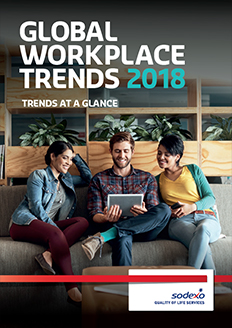Most companies recognize that their success depends not only on attracting the “best and the brightest” talent, but also on retaining, motivating, and engaging employees through a workplace experience and culture that allows them to thrive. However, this does not always translate into the realities routinely experienced by millions of employees across the globe.
Since 2012, we’ve scanned the horizon in our annual Global Workplace Trends Report. By understanding key trends that are shaping both the nature of the enterprise and the future of work, we’ve been able to more effectively help our clients plan for the future that lies ahead. In the 2018 iteration of the Global Workplace Trends, we looked at seven trends driving organizational change with the help of twenty future thinkers and strategists.
The 7 trends we explored this year

In an environment of constant progress, more organizations are questioning how future technology could impact their operations. More so than almost any other development, the Internet of Things (IoT) offers immediate improvements to the employee experience, from enhanced organization to more efficient facility management that boosts productivity.

Our lives are a kaleidoscope of up to 500 emotional experiences per day. We may only be conscious of a fraction of them at any one time, but they color every interaction. With this understanding comes a recognition of the need to navigate these emotions in the workplace, meaning that emotional intelligence (EI) has become a core skill set for high-performing organizations and outstanding leaders today.

2017 marked the first full year with Generation Z in the workforce—a cohort typically defined as being born between 1995 and 2012. As these new employees set their sights on becoming future movers and shakers, organizations need to know what Gen Z brings to the workplace in order to foster the vibrant multi-generational mix that every enterprise depends upon.

Faced with an often difficult “new normal” in the post-2008 economic sphere, both individuals and corporations are re-examining how their resources are used. Out of this has grown a “sharing” or “gig” economy; one that eschews traditional ownership to promote maximum efficiency of labor and materials.

For much of the recent past, business has taken a more direct approach to improving diversity in the workforce, particularly when it comes to addressing gender imbalances on teams. Now, with a growing awareness around the unique challenges faced by women in the workplace—and because of the significant value generated by improved diversity—it’s clear that the focus of diversity needs to include not only making the numbers add up but also instilling a true feeling of belonging and inclusion.

While new technologies have delivered significant benefits, workplace complexity continues to rise and global employee engagement levels remain low. As organizations look for ways to simplify interactions and reduce overload, the employee experience has come into focus as a key area for improvement—and Human Capital Management (HCM) is increasingly being leveraged as a solution.

To succeed in today’s business world, organizations need to become involved in more than just economics—they also need to become actors of change around large-scale environmental and social problems. However, responsible business is being nudged forward not only through business case logic, but because employees increasingly expect their employers to act responsibly.









